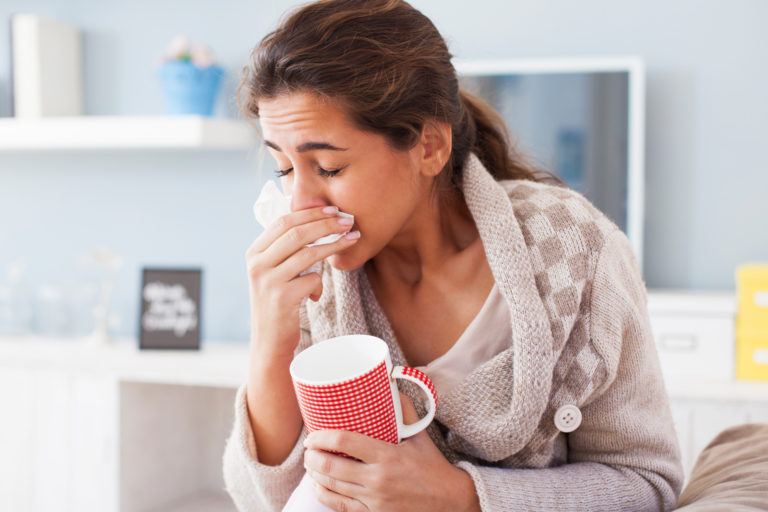
The remedy for your case of the chills will depend on the cause. I have a chronic case of the chills — I swear I am almost always cold. Most likely that’s just because I’m a skinny girl living in Minnesota. I’m sure I can be cured by getting the hell out of this part of the country. Chills happen when your muscles start to spasm in order to warm the body. This is most often a signal of an oncoming infection and a fever often follows. If you have several other symptoms like headache, sore throat, or vomiting, you likely have a viral or bacterial infection. Some infections should be treated by medical professionals. However, if you only have mild symptoms, they can be treated at home by various methods. Please remember that children should be treated significantly differently, and with advice from a medical professional.
Symptoms
- Muscle spasms (shivering)
- Fever (oftentimes)
- Goosebumps (sometimes)
Best Treatments for the Chills
Treat the Underlying Illness
If you have several symptoms, your best bet is to treat the underlying illness. Don’t just try and fix individual symptoms. Get to the bottom of what’s wrong and go from there. Chills can go along with any number and combination of other symptoms and therefore can be caused by all sorts of illnesses. Common causes are strep throat, flu, colds, mononucleosis, urinary tract infections, pneumonia, and on and on. Some of these causes definitely should bring you to a doctor and you might also have to go if you’re having trouble figuring out what’s making you sick.
Seek Medical Attention
Some cases should seek medical attention. If you’re looking after sick kids, bring them in if the fever isn’t dropping within a few hours after taking medicine. If an infant has a low-grade fever for more than a day, or has a dangerously high temperature—above 101 degrees Fahrenheit for babies under three months and 103 for older kids—get them to a doctor quickly. For adults: See a doctor if your fever is above 102 and hasn’t improved in three days, or you are experiencing abdominal pain, severe cough and/or difficulty breathing, confusion, neck stiffness, or lethargy. If you need an updated thermometer, Amazon sells quite a few nifty ones, like this Dual Mode version.
Rest and Fluids
The first step of home care is rest and plenty of fluids.This is pretty standard advice for just about any mild sickness. If you are just having chills, possibly with other light symptoms, they should go away in time. Resting will help give your body the energy it needs to fight off whatever kind of infection is trying to take over. It’s always a good thing to stay hydrated. Fluids are a necessity when you’re sick because they flush out all the unwanted, illness-causing crap in your system. If you’re running low on elctrolytes and fluids, Pedialyte is a good way to replenish them, sold at Amazon.
Medicine
When you have chills and a fever, medicine and a lukewarm cloth can cool you down. This works for a low-grade fever, anyway. Over-the-counter medication like acetaminophen will help lower a fever and reduce pain if you have a headache or body aches. Remember not to give aspirin to kids—only non-aspirin products. Patting skin with a lukewarm (not cold!) washcloth will also lower your temperature by water evaporation. Cold water will only throw your body temp more out of whack. By lowering your fever, you are regulating your body temperature, which will combat the chills too.
Hypothermia
If you have the chills with no fever, hypothermia might be a threat. Hypothermia is when your body temperature gets too low from cold weather or cold water. There are several levels of severity. If your temperature is below the usual 98.6 degrees and you are shivering uncontrollably, you could very well have mild hypothermia. Stay dry, try to warm up, and drink lots of warm fluids. If your temperature is below 96 and you are confused or can’t control your bodily movements, get emergency help immediately.
Treatment for the Chills Will Vary
There are several factors that need to be considered when trying to rid yourself of the chills. The most important of these is the body temperature and age of the person who is ill. All other symptoms need to be taken into account as well. Children need special attention for their illnesses. They cannot be treated as adults and the level of their temperature will directly affect treatment. If you’re unsure of what to do, doctors will always be your best source of information, especially if chills are only one out of the plethora of reasons why you feel like death warmed over. However, if your symptoms are few and mild, you will probably be fine after lots of rest and fluids (the only true natural cure).
Beware the Old Wives’ Tales!
Rubbing Alcohol
When a washcloth soaked in rubbing alcohol is sponged on the skin, the skin feels cooler. This will help your fever, right? Maybe. But then you risk alcohol poisoning. This is especially true for kids because it doesn’t take much to get into their little bodies. Using lukewarm water will do the same thing with no harmful side effects.
Starve a Fever, Feed a Cold
This one goes way back. The theory was that high temps meant fevers and low temps meant colds, and by consuming less or more calories your temperature will go down for a fever and up for a cold. Not really. No matter your temperature, eat healthy.
Sweat Out a Fever
Wrong again. Having a fever is not a bad thing, unless it gets too high. It’s the body’s way of trying to fight off infection. If you’re covered in blankets, you actually can worsen your fever because this will raise your temperature even more (which is definitely not what you want).